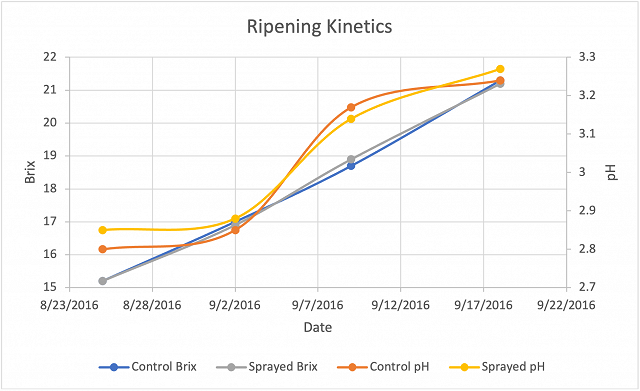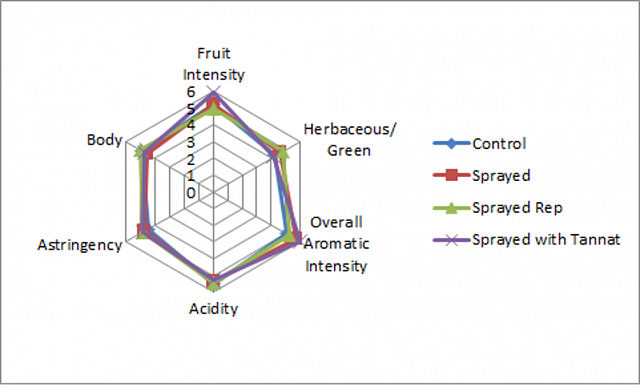The Effect of LalVigne Foliar Spray on Chambourcin (2016)
Meaghan Tardif
Fabbioli Cellars
Summary
This study examines the impact that LalVigne Foliar Spray (ScottLabs) has on the ripeness of Chambourcin grapes. Lalvigne was sprayed at 5% veraison and then 7-9 days later on a 2 acre parcel of Chambourcin at the recommended rate. Control and treatment grapes from the same block were harvested and processed on the same day, fermented separately as 1.5 ton lots in T Bins, and all other treatments between fermentations were kept the same. A third treatment was also added, were 75 pounds of Tannat skins were added to LalVigne-treated grapes at the beginning of fermentation. Although ripening kinetics between each treatment were similar (data not shown), anecdotally, the sprayed berries exhibited more color development. Juice from LalVigne-treated grapes exhibited higher nitrogen numbers (except lower ammonia). Wine produced with Tannat skins added had lower alcohol and pH (58% increase in proton concentration). In general, grapes treated with LalVigne showed increased color intensity and increased amounts of phenolic compounds. The sprayed grapes showed a large increase in Malvidin glucoside but a slightly lower count of monomeric and total anthocyanins. Tannat skins added to the LalVigne sprayed wine showed a smaller increase in color intensity, a larger increase in catechin, epicatechin, gallic acid, and tannin, and a decrease in anthocyanin content. For the triangle test, of 21 people who answered, 9 people chose the correct wine (43%), suggesting the wines were not significantly different. In general, people who answered correctly had a slight preference for the sprayed wine, but this preference was very weak. Descriptive analysis did not show many trends between wines. The control tended to have slightly lower Overall Aromatic Intensity to the sprayed wines, and the wine with Tannat skins seemed to have higher Fruit Intensity. The LalVigne spray wines tended to have slightly higher Herbaceous/Green scores, except for the wine with Tannat added.
Introduction
LalVigne Mature Foliar Spray (ScottLabs) is a yeast-derived organic foliar spray which is marketed to concentrate aroma precursors and mature phenolic attributes in berries. It is intended to help produce grapes of higher quality in shorter growing/ripening seasons (Scott Laboratories 2016). Several studies have shown tasters who prefer wine produced with LalVigne Foliar Spray. It has been said to increase mouthfeel and volume in Merlot and Syrah, and to increase aromatic intensity in Merlot. It also appears to reduce IBMP, depending on the base levels of this compound (Lallemand 2015).
Results and Discussion
Although ripening kinetics between each treatment were similar, anecdotally, the sprayed berries exhibited more color development. Juice from LalVigne-treated grapes exhibited higher nitrogen numbers (except lower ammonia). Wine produced with Tannat skins added had lower alcohol and pH (58% increase in proton concentration). In general, grapes treated with LalVigne showed increased color intensity and increased amounts of phenolic compounds. The sprayed grapes showed a large increase in malvidin glucoside but a slightly lower count of monomeric and total anthocyanins. Tannat skins added to the LalVigne sprayed wine showed a smaller increase in color intensity, a larger increase in catechin, epicatechin, gallic acid, and tannin, and a decrease in anthocyanin content. For the triangle test (comparing sprayed and unsprayed wines), of 21 people who answered, 9 people chose the correct wine (43%), suggesting the wines were not significantly different. In general, people who answered correctly had a slight preference for the sprayed wine, but this preference was very weak. Descriptive analysis did not show any strong trends between wines. The control tended to have slightly lower Overall Aromatic Intensity to the sprayed wines, and the wine with Tannat skins seemed to have higher Fruit Intensity. The LalVigne spray wines tended to have slightly higher Herbaceous/Green scores, except for the wine with Tannat added.








Methods
A Chambourcin vineyard which has had 3 separate areas of the plantings sampled to see ripening trends have shown that all areas ripen similarly. The vineyard has similar slope, drainage, and other viticultural relations, and all grapes were planted at the same time. LalVigne Foliar Spray product was sprayed at 5% veraison and then 7-9 days later on a 2 acre parcel of Chambourcin at recommended rate by Scott Labs, while another region was left unsprayed. As harvest approached this lot was sampled weekly along with the non-sprayed lot. Brix, pH, and berry sensory analysis were tested at each point for comparison.
Both lots were harvested separately on the same day (9/27), refrigerated overnight and crushed on 9/28. A 36 hour cold soak was performed. The wines were fermented the same way with the addition on BM4x4 (rehydrated with Go Ferm), Fermaid K, Color X, and oak chips at recommended rates. A last bin received 1.5 tons of LalVigne-Sprayed Chambourcin with Tannat Skins added, for a total of three different treatments. The must was treated with 35ppm sulfur dioxide. Brix and pH were adjusted among both lots to 21.9 and 3.24. Juice samples were sent out for YAN analysis. YAN was adjusted between juices to achieve 300ppm on 9/30, and all other fermentation treatments between each lot were the same. At the end of fermentation (10/6), both wines were pressed and inoculated with ML VP41. On 10/7 the wines were splash racked into barrels.
This wine was tasted on the April 12, 2017 tasting. For the triangle test and preference analysis, anybody who did not answer the form were removed from consideration for both triangle, degree of difference, and preference. Additionally, anybody who answered the triangle test incorrectly were removed from consideration for degree of difference and preference. Additionally, any data points for preference which did not make sense (such as a person ranking a wine and its replicate at most and least preferred, when they correctly guessed the odd wine) were removed.
In order to balance the data set to perform statistical analysis for descriptive analysis, any judge who had not fully completed the descriptive analysis ratings were removed. In order to then make the amount of judges between groups equivalent, one judge from group 2 was transferred to group 1 and group 3. This resulted in a final data set of 3 groups, each with 6 judges (considered as replications within groups, and groups were considered as assessors). Data was analyzed using Panel Check V1.4.2. Because this is not a truly statistical set-up, any results which are found to be statistically significant (p<0.05) will be denoted as a “strong trend” or a “strong tendency,” as opposed to general trends or tendencies. The statistical significance here will ignore any other significant effects or interactions which may confound the results (such as a statistically significant interaction of Judge x Wine confounding a significant result from Wine alone). The descriptors used in this study were Fruit Intensity, Herbaceous/Green, Overall Aromatic Intensity, Acidity, Astringency, and Body.
References
Scott Laboratories. 2016. Lalvigne Foliar Spray: Organic yeast derivative foliar spray. http://www.scottlab.com/products-164.aspx. Accessed 5/8/2016.
Lallemand. 2015. LalVigne MATURE & LalVigne AROMA: New, innovative toolds for viticulturists and enologists. http://www.lallemandwine.com/north-america/lalvigne-mature-lalvigne-aroma-new-innovative-tools-for-viticulturists-and-enologists/. Accessed 5/8/2016.
